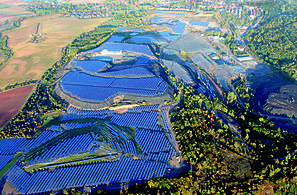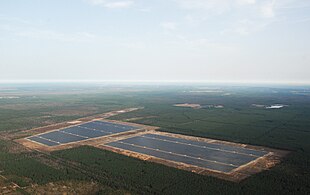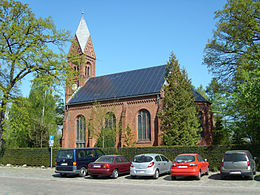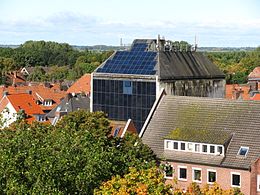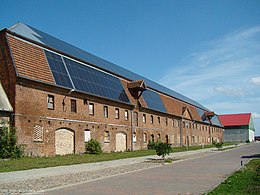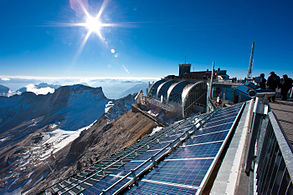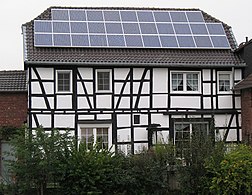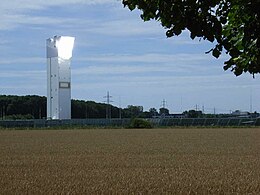Solar power in Germany

- Brown coal: 77.5 TW⋅h (17.7%)
- Hard coal: 36.05 TW⋅h (8.3%)
- Natural gas: 45.79 TW⋅h (10.5%)
- Wind: 139.77 TW⋅h (32.0%)
- Solar: 53.48 TW⋅h (12.2%)
- Biomass: 42.25 TW⋅h (9.7%)
- Nuclear: 6.72 TW⋅h (1.5%)
- Hydro: 19.48 TW⋅h (4.5%)
- Oil: 3.15 TW⋅h (0.7%)
- Other: 12.59 TW⋅h (2.9%)
Germany has been among the
According to the Fraunhofer Institute for Solar Energy Systems, in 2022, Germany generated 60.8 TWh from solar power, or 11% of Germany's gross electricity consumption.[11]: 6
The country is increasingly producing more electricity at specific times with high
History
Price of solar PV systems
Graphs are unavailable due to technical issues. There is more info on Phabricator and on MediaWiki.org. |
Germany was one of the first countries to deploy grid-scale PV power. In 2004, Germany was the first country, together with Japan, to reach 1 GW of cumulative installed PV capacity. Since 2004 solar power in Germany has been growing considerably due to the country's feed-in tariffs for renewable energy, which were introduced by the German Renewable Energy Sources Act, and declining PV costs.
Prices of PV systems/solar power system decreased more than 50% in the 5 years since 2006.[15] By 2011, solar PV provided 18 TWh of Germany's electricity, or about 3% of the total.[16] That year the federal government set a target of 66 GW of installed solar PV capacity by 2030,[17] to be reached with an annual increase of 2.5–3.5 GW,[18] and a goal of 80% of electricity from renewable sources by 2050.[19]
More than 7 GW of PV capacity were installed annually during the record years of 2010, 2011 and 2012. For this period, the installed capacity of 22.5 GW represented almost 30% of the worldwide deployed photovoltaics.
Since 2013, the number of new installations declined significantly due to more restrictive governmental policies.
About 1.5 million
It's estimated that by 2017 over 70% of the country's jobs in the solar industry have been lost in the solar sector in recent years.
A boom in small, residential balcony-mounted solar systems has been reported in the early 2020s.[20][21][22]
Governmental policies
Feed-in tariff for rooftop solar[23]
Graphs are unavailable due to technical issues. There is more info on Phabricator and on MediaWiki.org. |
As of 2012[update], the feed-in tariff (FiT) costs about €14 billion (US$18 billion) per year for wind and solar installations. The cost is spread across all rate-payers in a surcharge of 3.6 €ct (4.6 ¢) per kWh[24] (approximately 15% of the total domestic cost of electricity).[25] On the other hand, as expensive peak power plants are displaced, the price at the power exchange is reduced due to the so-called
According to the solar power industry, a feed-in tariff is the most effective means of developing solar power.[28] It is the same as a power purchase agreement, but is at a much higher rate. As the industry matures, it is reduced and becomes the same as a power purchase agreement. A feed-in tariff allows investors a guaranteed return on investment – a requirement for development. A primary difference between a tax credit and a feed-in tariff is that the cost is borne the year of installation with a tax credit, and is spread out over many years with a feed-in tariff. In both cases the incentive cost is distributed over all consumers. This means that the initial cost is very low for a feed-in tariff and very high for a tax credit. In both cases the learning curve reduces the cost of installation, but is not a large contribution to growth, as grid parity is still always reached.[29]
Since the end of the boom period, national PV market has since declined significantly, due to the amendments in the German Renewable Energy Sources Act (EEG) that reduced feed-in tariffs and set constraints on utility-scaled installations, limiting their size to no more than 10 kW.[30]
The previous version of the EEG only guaranteed financial assistance as long as the PV capacity had not yet reached 52 GW. This limit has now been removed. It also foresees to regulate annual PV growth within a range of 2.5 GW to 3.5 GW by adjusting the guaranteed fees accordingly. The legislative reforms stipulates a 40 to 45 per cent share from renewable energy sources by 2025 and a 55 to 60 per cent share by 2035.[31]
As of November 2016[update], tenants in North Rhine-Westphalia (NRW) will soon be able to benefit from the PV panels mounted on the buildings in which they live. The state government has introduced measures covering the self-consumption of power, allowing tenants to acquire the electricity generated onsite more cheaply than their regular utility contracts stipulate.[32][33]
Grid capacity and stability issues

This section may be confusing or unclear to readers. (July 2014) |
In 2017, approximately 9 GW of photovoltaic plants in Germany were being retrofitted to shut down[34] if the frequency increases to 50.2 Hz, indicating an excess of electricity on the grid. The frequency is unlikely to reach 50.2 Hz during normal operation, but can if Germany is exporting power to countries that suddenly experience a power failure. This leads to a surplus of generation in Germany, that is transferred to rotating load and generation, which causes system frequency to rise. This happened in 2003 and 2006.[35][36][37]
However, power failures could not have been caused by photovoltaics in 2006, as solar PV played a negligible role in the German energy mix at that time.
Potential
Germany has about the same solar potential as Alaska, which has an average of 3.08 sun hours/day in Fairbanks.[citation needed]
Bremen Sun Hours/day (Avg = 2.92 hrs/day)
Graphs are unavailable due to technical issues. There is more info on Phabricator and on MediaWiki.org. |
Stuttgart Sun Hours/day (Avg = 3.33 hrs/day)
Graphs are unavailable due to technical issues. There is more info on Phabricator and on MediaWiki.org. |
Source: NREL, based on an average of 30 years of weather data.[41]
Statistics



The history of Germany's installed photovoltaic capacity, its average power output, produced electricity, and its share in the overall consumed electricity, showed a steady, exponential growth for more than two decades up to about 2012. [dubious ] Solar PV capacity doubled on average every 18 months in this period; an annual growth rate of more than 50 per cent. Since about 2012 growth has slowed down significantly.
Generation
| Year | Capacity (MW) |
Net annual generation (GWh) |
% of gross electricity consumption |
Capacity Factor (%) |
|---|---|---|---|---|
| 1990 | 2 | 1 | 2e-04 | 5.7 |
| 1991 | 2 | 1 | 2e-04 | 5.7 |
| 1992 | 6 | 4 | 7e-04 | 7.6 |
| 1993 | 9 | 3 | 6e-04 | 3.8 |
| 1994 | 12 | 7 | 0.001 | 6.7 |
| 1995 | 18 | 7 | 0.001 | 4.4 |
| 1996 | 28 | 12 | 0.002 | 4.9 |
| 1997 | 42 | 18 | 0.003 | 4.9 |
| 1998 | 54 | 35 | 0.006 | 7.4 |
| 1999 | 70 | 30 | 0.005 | 4.9 |
| 2000 | 114 | 60 | 0.01 | 6.0 |
| 2001 | 176 | 76 | 0.013 | 4.9 |
| 2002 | 296 | 162 | 0.028 | 6.2 |
| 2003 | 435 | 313 | 0.052 | 8.2 |
| 2004 | 1105 | 557 | 0.091 | 5.8 |
| 2005 | 2056 | 1282 | 0.21 | 7.1 |
| 2006 | 2899 | 2220 | 0.36 | 8.7 |
| 2007 | 4170 | 3075 | 0.49 | 8.4 |
| 2008 | 6120 | 4420 | 0.72 | 8.2 |
| 2009 | 10566 | 6583 | 1.13 | 7.1 |
| 2010 | 18006 | 11729 | 1.9 | 7.4 |
| 2011 | 25916 | 19599 | 3.23 | 8.6 |
| 2012 | 34077 | 26220 | 4.35 | 8.8 |
| 2013 | 36710 | 30020 | 5.13 | 9.6 |
| 2014 | 37900 | 34735 | 6.08 | 10.9 |
| 2015 | 39224 | 37330 | 6.5 | 11.3 |
| 2016 | 40679 | 36820 | 6.4 | 10.7 |
| 2017 | 42293 | 38001 | 6.6 | 10.6 |
| 2018 | 45158 | 43451 | 7.7 | 11.6 |
| 2019 | 48864 | 44334 | 8.2 | 11.1 |
| 2020 | 54403 | 48525 | 8.9 | 10.1 |
| 2021 | 60108 | 48373 | 8.7 | 9.1 |
| 2022 | 67399 | 59596 | 11.1 | 10.1 |
Source:
: 16–41Note: This table does not show net consumption but gross electricity consumption, which includes self-consumption of nuclear and coal-fire power plants. In 2014, net consumption stood at about 6.9% (vs. 6.1% for gross consumption).[4]: 5
Graphs are unavailable due to technical issues. There is more info on
Federal Ministry for Economic Affairs and Energy[6] : 7 Solar PV by type
It is interesting to note that whilst large power plants receive a lot of attention in solar power articles, installations under 0.5 MW in size actually represented nearly two-thirds of the installed capacity in Germany in 2017. PV capacity by federal states
Germany is made up of sixteen, partly sovereign federal states or Länder. The southern states of Bavaria and Baden-Württemberg account for about half of the total, nationwide PV deployment and are also the wealthiest and most populous states after North Rhine-Westphalia. However, photovoltaic installations are widespread throughout the sixteen states and are not limited to the southern region of the country as demonstrated by a watts per capita distribution.
Photovoltaic power stations
Largest photovoltaic power stationsOther notable photovoltaic stationsGallery
CompaniesSome companies have collapsed since 2008, facing harsh competition from imported solar panels. Some were taken over like Bosch Solar Energy by SolarWorld. Major German solar companies include: See also
References
External linksWikimedia Commons has media related to Solar power in Germany.
|


